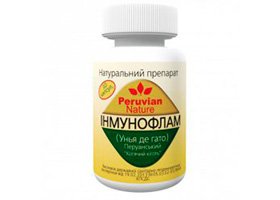
All iLive content is medically reviewed or fact checked to ensure as much factual accuracy as possible.
We have strict sourcing guidelines and only link to reputable media sites, academic research institutions and, whenever possible, medically peer reviewed studies. Note that the numbers in parentheses ([1], [2], etc.) are clickable links to these studies.
If you feel that any of our content is inaccurate, out-of-date, or otherwise questionable, please select it and press Ctrl + Enter.
Immunoflam
Medical expert of the article
Last reviewed: 03.07.2025

Inmunoflam belongs to the group of immunomodulatory agents and cytokines.
ATC classification
Active ingredients
Pharmacological group
Pharmachologic effect
Indications Inmunoflama
It is used for the following disorders:
- in the combined treatment of rheumatism with radiculitis, as well as rheumatoid arthritis and other general connective tissue lesions;
- ulcers affecting the gastrointestinal tract;
- cholecystitis, metabolic disorders and colitis;
- menstrual cycle disorders, fibroids, general candidiasis or impotence;
- respiratory diseases of viral origin;
- immune damage or allergic reactions;
- epidermal pathologies and herpes;
- pathologies of an oncological nature or affecting the functioning of the cardiovascular system or endocrine system.
Used to prevent the development of acute respiratory viral infections, allergic symptoms and immune disorders.
Release form
The drug is released in capsules, 30 pieces per bottle.
Pharmacodynamics
"Cat's claw" is a tree-like liana growing in the Peruvian forests. The substance has anti-inflammatory, antihypertensive, adaptogenic, analgesic, immunomodulatory, and antioxidant activity. In addition, it slows down the process of tumor proliferation.
For use in modern medicine, a powder extract formed from the bark of such vines is used. It contains all the bioactive components of the plant: penta-, as well as tetracyclic oxyindole alkaloids, as well as polyphenols with phenols, triterpenes and glycosides contained in quinic acid, with steroids.
Oxyindole alkaloids with "cat's claw" (pteropodin, mitraphylline with speciophiline, uncarin with rhynchophylline, etc.) have pronounced antiarrhythmic, antiviral, immunostimulating (stimulation of phagocytosis processes), antiplatelet, and in addition antiulcer, anti-inflammatory, antiasthmatic, anticarcinogenic and hypocholesterolemic properties. They can also slow down the activity of MAO and have a muscle relaxant and vasodilatory effect.
The phenolic group includes catechins (called epicatechins) with proanthocyanidins. Epicatechins have a powerful antioxidant, antimutagenic and P-vitamin effect. Leucoanthocyanidins increase the sensitivity of tumor cells to ionizing radiation, which increases the effectiveness of radiotherapy in people with oncology.
Along with this, proanthocyanidinamines inhibit enzymatic processes of reduction-oxidation inside tumor cells (demonstrate antitumor activity). Also, epicatechins also have antiviral (this includes viruses that cause herpes and hepatitis), anticoagulant and antihistamine effects.
Glycosides contained in quinic acid cause the development of an antiviral effect, and triterpene-type saponins cause antisclerotic, antibacterial, and antitumor effects.
Campestrol with stigmasterol (steroids) lead to the development of analgesic and antibacterial effects, and at the same time promote hair growth.
Dosing and administration
The dosage is selected individually. Children over 6 years of age and adults are prescribed 1 capsule once a day (recommended in the morning), half an hour before meals; the medicine should be washed down with 0.5-1 glass of plain water. The therapy should last 2-3 months, with a 5-7-day break after each month.
If necessary, taking into account the severity of the disease, it is permissible to increase the daily dose to 3-6 capsules.
To prevent diseases, it is prescribed to take 1 capsule every other day for a 2-3 month cycle.
 [ 2 ]
[ 2 ]
Use Inmunoflama during pregnancy
There is no information regarding the use of Inmunoflam during breastfeeding or pregnancy, so it is not prescribed to such patients.
You must stop taking the medication at least 1 month before you plan to conceive.
Contraindications
It is contraindicated for people with severe intolerance to the components of the drug, as well as in conditions after organ transplantation.
Side effects Inmunoflama
Occasionally, allergy symptoms or changes in stool consistency may occur.
 [ 1 ]
[ 1 ]
Storage conditions
Inmunoflam must be kept in a dark place, out of reach of children. Temperature indicators – within 25°C.
Shelf life
Inmunoflam can be used for a period of 3 years from the date of manufacture of the pharmaceutical substance.
 [ 3 ]
[ 3 ]
Application for children
For children under 6 years of age, it is recommended to prescribe the drug in a different form of release.
Manufacturer
Attention!
To simplify the perception of information, this instruction for use of the drug "Immunoflam" translated and presented in a special form on the basis of the official instructions for medical use of the drug. Before use read the annotation that came directly to medicines.
Description provided for informational purposes and is not a guide to self-healing. The need for this drug, the purpose of the treatment regimen, methods and dose of the drug is determined solely by the attending physician. Self-medication is dangerous for your health.

